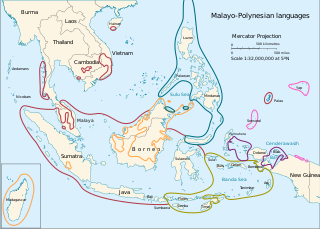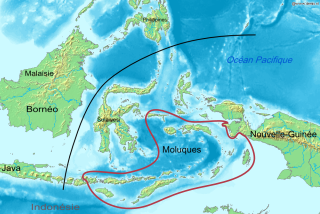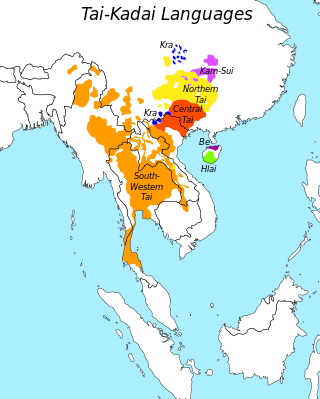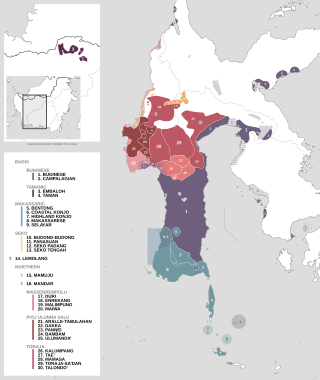Related Research Articles

The Malayo-Polynesian languages are a subgroup of the Austronesian languages, with approximately 385.5 million speakers. The Malayo-Polynesian languages are spoken by the Austronesian peoples outside of Taiwan, in the island nations of Southeast Asia and the Pacific Ocean, with a smaller number in continental Asia in the areas near the Malay Peninsula, with Cambodia, Vietnam and the Chinese island Hainan as the northwest geographic outlier. Malagasy, spoken on the island of Madagascar off the eastern coast of Africa in the Indian Ocean, is the furthest western outlier.
The Central–Eastern Malayo-Polynesian (CEMP) languages form a proposed branch of the Malayo-Polynesian languages consisting of over 700 languages.
Paragoge is the addition of a sound to the end of a word. It is a type of vowel epenthesis.

The Central Malayo-Polynesian languages (CMP) are a proposed branch in the Malayo-Polynesian subgroup of the Austronesian language family. The languages are spoken in the Lesser Sunda and Maluku Islands of the Banda Sea, in an area corresponding closely to the Indonesian provinces of East Nusa Tenggara and Maluku and the nation of East Timor, but with the Bima language extending to the eastern half of Sumbawa Island in the province of West Nusa Tenggara and the Sula languages of the Sula archipelago in the southwest corner of the province of North Maluku. The principal islands in this region are Sumbawa, Sumba, Flores, Timor, Buru, and Seram. The numerically most important languages are Bima, Manggarai of western Flores, Uab Meto of West Timor, and Tetum, the national language of East Timor.

The South Halmahera–West New Guinea (SHWNG) languages are a branch of the Malayo-Polynesian languages, found in the islands and along the shores of the Halmahera Sea in the Indonesian province of North Maluku and of Cenderawasih Bay in the provinces of Papua and West Papua. There are 38 languages.
In historical linguistics, a linkage is a network of related dialects or languages that formed from a gradual diffusion and differentiation of a proto-language.
Proto-Austronesian is a proto-language. It is the reconstructed ancestor of the Austronesian languages, one of the world's major language families. Proto-Austronesian is assumed to have begun to diversify c. 4000 BCE – c. 3500 BCE in Taiwan.

The Austro-Tai languages, sometimes also Austro-Thai languages, are a proposed language family that comprises the Austronesian languages and Kra–Dai languages.
The Greater North Borneo languages are a proposed subgroup of the Austronesian language family. The subgroup historically covers languages that are spoken throughout much of Borneo and Sumatra, as well as parts of Java, and Mainland Southeast Asia. The Greater North Borneo hypothesis was first proposed by Robert Blust (2010) and further elaborated by Alexander Smith. The evidence presented for this proposal are solely lexical. Despite its name, this branch has been now widespread within the Maritime Southeast Asia region.
The Northwest Sumatra–Barrier Islands languages are a group of Malayo-Polynesian languages spoken by the Batak and related peoples in the interior of North Sumatra and by the Nias, Mentawai people, and others on the Barrier islands off the western coast of Sumatra, Indonesia.

The South Sulawesi languages are a subgroup of the Austronesian language family. They are primarily spoken in the Indonesian provinces of South Sulawesi and West Sulawesi, with a small outlying pocket in West Kalimantan.
The Central Maluku languages are a proposed subgroup of the Central–Eastern Malayo-Polynesian branch of the Austronesian language family which comprises around fifty languages spoken principally on the Seram, Buru, Ambon and the Sula Islands, Indonesia. None of the languages have as many as fifty thousand speakers, and several are extinct.
The Piru Bay languages are a group of twenty Malayo-Polynesian languages, spoken on Ambon Island and around Piru Bay on the island of Seram, Indonesia. None of the languages have more than about twenty thousand speakers, and several are endangered with extinction.

The Celebic languages are a subgroup of the Austronesian languages spoken on the Indonesian island of Sulawesi, formerly called Celebes. Almost all of the languages spoken in the provinces of Central Sulawesi and Southeast Sulawesi belong to the Celebic group. A few Celebic languages are located in South Sulawesi province. By number of languages, Celebic is the largest subgroup of Austronesian languages on Sulawesi.
Isidore Dyen was an American linguist, Professor Emeritus of Malayo-Polynesian and Comparative Linguistics at Yale University. He was one of the foremost scholars in the field of Austronesian linguistics, publishing extensively on the reconstruction of Proto-Austronesian phonology and on subgrouping within the language family, the latter principally by means of lexicostatistics.
Proto-Malayo-Polynesian (PMP) is the reconstructed ancestor of the Malayo-Polynesian languages, which is by far the largest branch of the Austronesian language family. Proto-Malayo-Polynesian is ancestral to all Austronesian languages spoken outside Taiwan, as well as the Yami language on Taiwan's Orchid Island. The first systematic reconstruction of Proto-Austronesian ("Uraustronesisch") by Otto Dempwolff was based on evidence from languages outside of Taiwan, and was therefore actually the first reconstruction of what is now known as Proto-Malayo-Polynesian.
Manusela is an Austronesian language spoken in Seram, Indonesia. It is classified by Collins (1983) as a member of the Central Maluku subgroup.
Watubela is an Austronesian language of the Maluku Islands, Indonesia. It is closely related to Geser.
The Proto-Philippine language is a reconstructed ancestral proto-language of the Philippine languages, a proposed subgroup of the Austronesian languages which includes all languages within the Philippines as well as those within the northern portions of Sulawesi in Indonesia. Proto-Philippine is not directly attested to in any written work, but linguistic reconstruction by the comparative method has found regular similarities among languages that cannot be explained by coincidence or word-borrowing.
The Moklenic or Moken–Moklen languages consist of a pair of two closely related but distinct languages, namely Moken and Moklen. Larish (1999) establishes the two languages as forming two distinct subgroups of a larger Moken–Moklen branch. Larish (2005) suggests Moklenic as an alternative name for Moken–Moklen, the latter term which was originally used by Larish (1999).
References
- ↑ Zobel, Erik (2024). "Historical linguistics of the Central Malayo-Polynesian languages". In Alexander Adelaar; Antoinette Schapper (eds.). The Oxford Guide to the Malayo-Polynesian Languages of Southeast Asia. Oxford University Press. pp. 151–164. doi:10.1093/oso/9780198807353.003.0012.